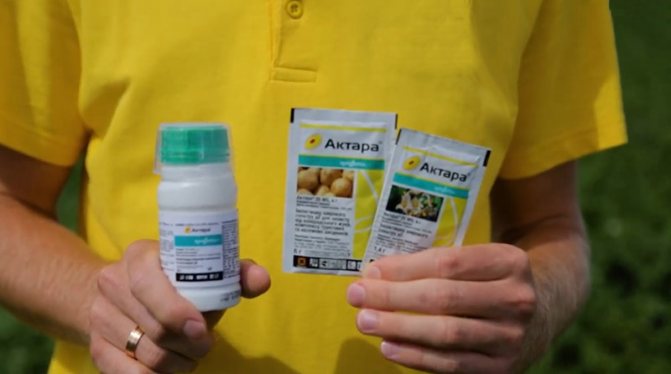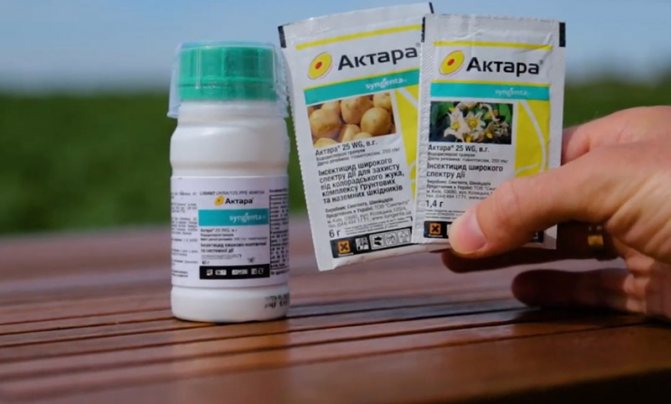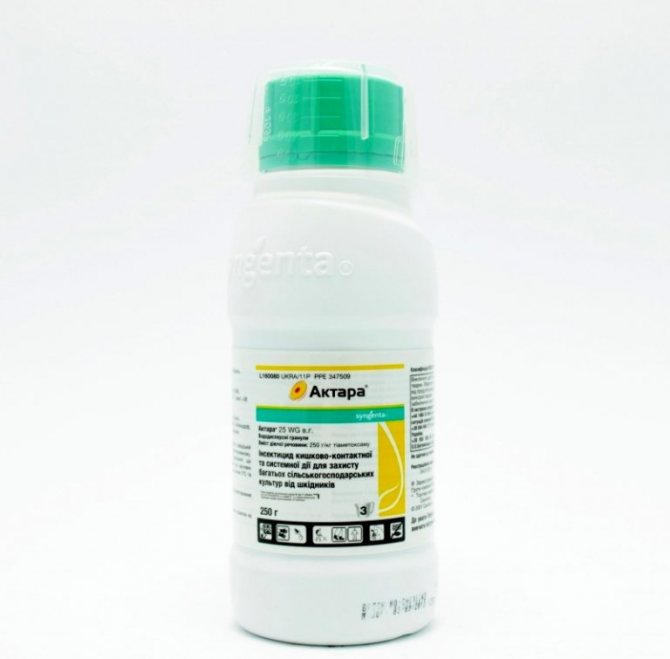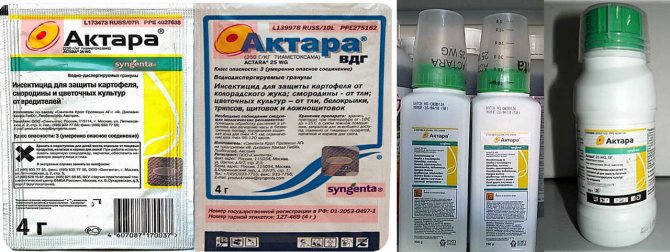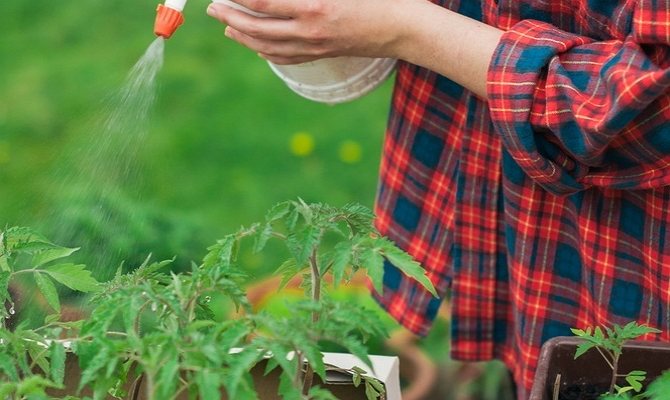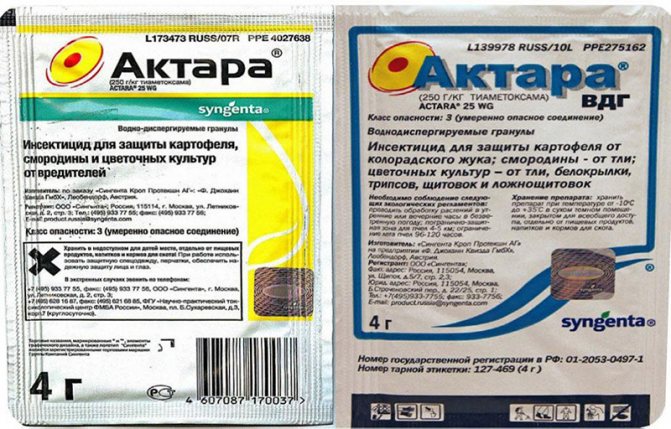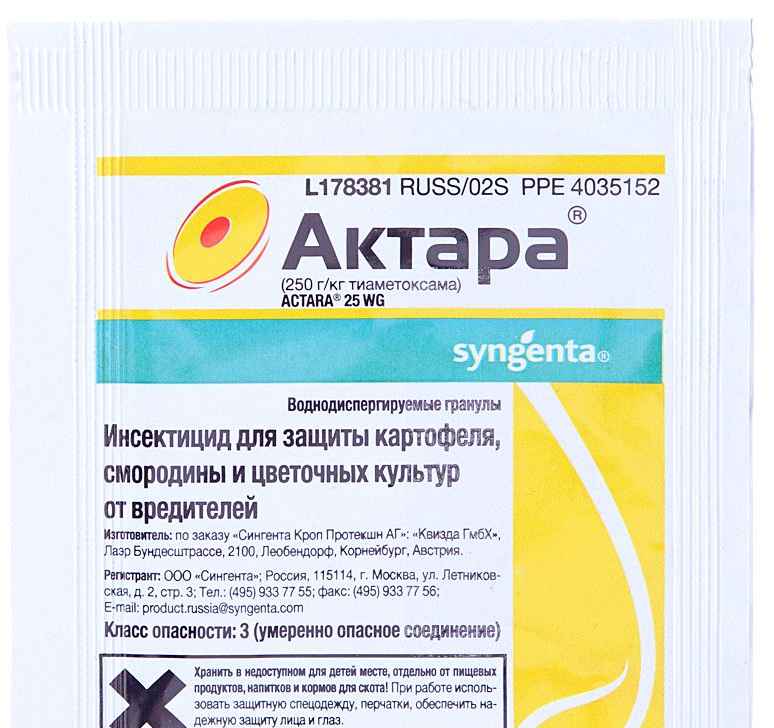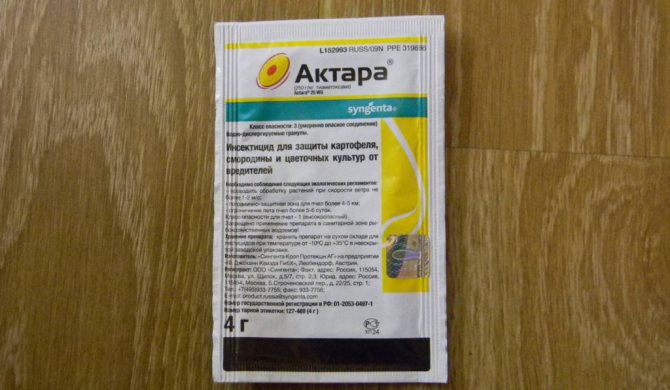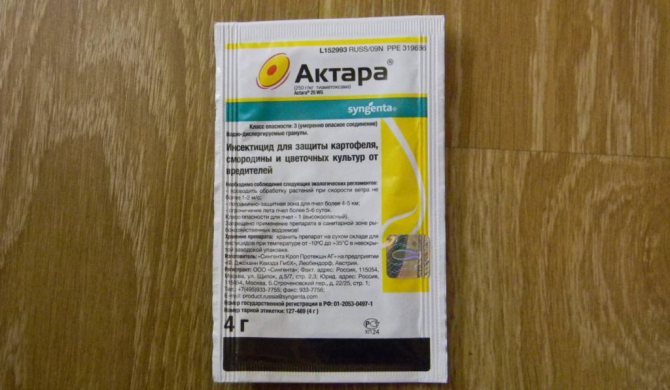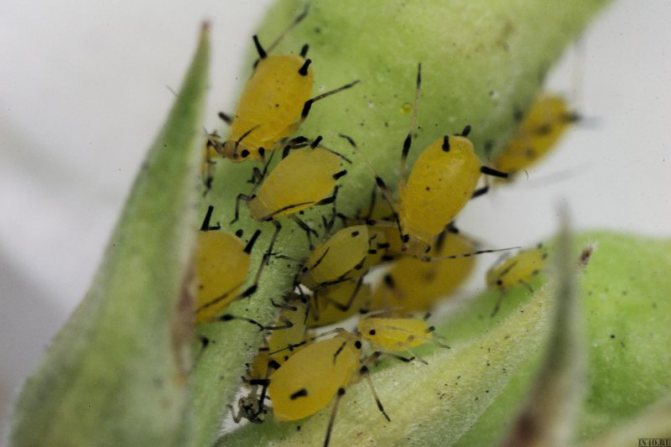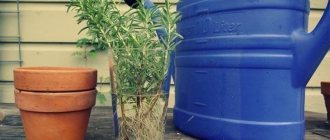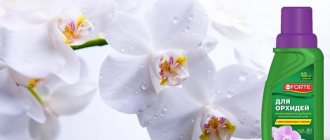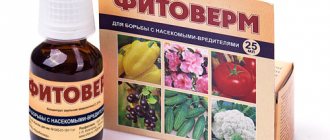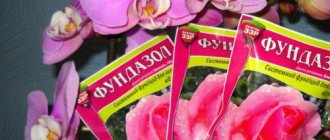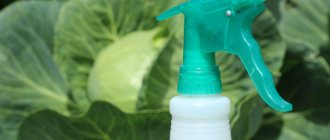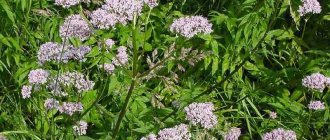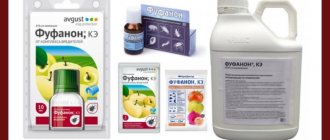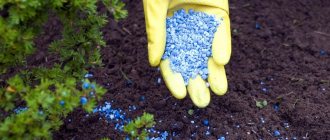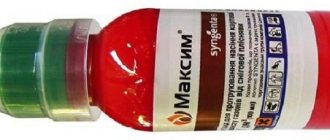Composition and form of release
Aktara is a drug of contact-intestinal action, an insecticide belonging to the group of neonicotinoids. Produced by Syngenta in the form of water-dispersible granules and suspension concentrate.
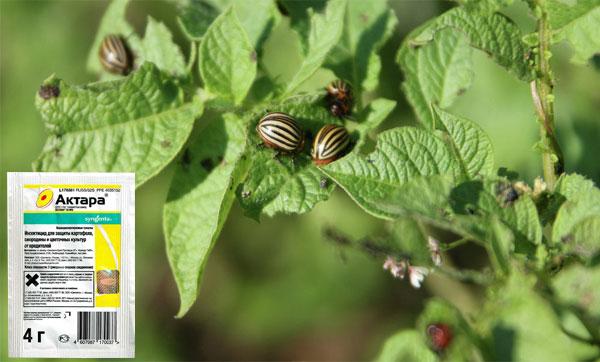
The volume of the dry preparation is 4 and 250 g, liquid is poured into bottles of 250 ml and 1 liter. Aktara is also produced in ampoules - 1 ml each. In ampoules (and vials of 0.5 l), the suspension is packaged, although the drug is produced by Syngenta.
The active ingredient of Aktara is thiamethoxam, it contains 250 g / kg and 240 g / l. The insecticide has a long protective effect - from 3 weeks to 2 months from the date of treatment (depending on the weather and the method of application - spraying or watering). It will be effective even if you work in heat or high humidity, but the best temperature is 12-25˚С.
Analogs of Aktara insecticide
The tool is indispensable for fighting the "army" of gnawing, sucking and other types of harmful insects. But Aktara, like most drugs, has analogues. They have proven themselves to be excellent: "ALOTAR", "FAYTER", "TIARA", "NOMINAL", "EUFORIA". The insecticidal properties of these substances have a similar effect on application. They also include a component - Thiamethoxam.
"Aktara" is a high-speed, fast-acting drug. Do not forget about personal protective measures. If you carry out competent processing measures, then you can forget about pests for a long time, save and increase your harvest.
Indications for use
The tool is used for spraying vegetables, shrubs, trees, flowers, applying to the soil, processing tubers and vegetable seedlings before planting. Thiamethoxam dissolves well, is absorbed by plants both from the leaves and from the soil, but does not accumulate in the soil, but decomposes in it.
The drug Aktara is used for the Colorado potato beetle, wireworm, scale insects and false scutes, thrips, whiteflies, in potted flowers - for soil flies and mushroom mosquitoes.
From aphids, Aktar is used on flowers and currants. As for the use of this drug for spider mites, it is ineffective in this case, since it is an insecticide, not an acaricide. On indoor flowers, Aktar is also used for mealybugs.
Granules are used on grapes, eggplants, pears, cabbage, peppers, cucumbers, onions, potatoes, apples, flowers, roses, tomatoes and currants. The suspension is used on grapes, potatoes, apples, currants, pears, and potted flowers.
Application of Aktara for seedlings
We recommend reading our other articles
- Green pest soap
- Aphids on an apple tree
- Winter varieties of pears
- Insecticide Confidor
Seedlings of cabbage, blue eggplants, tobacco, tomatoes, sweet peppers: before planting, the roots of plants are soaked in a solution of Aktar insecticide at a temperature of at least 18 ° C for 2 hours before planting, 200-250 seedlings need about 1 liter of solution.
When soaking plants (200-250pcs), dilute the contents of the package (1.4gr) in 1 liter of clean water. Add water to the remaining solution to 10 liters and the resulting solution can be watered after planting. In this case, Aktara is valid for 60-70 days.
Potatoes: before planting potatoes, the preparation is applied to the rows. Strawberry: It is recommended to water the plants after harvesting with 0.25% working solution.
Preparation and processing


The drug is diluted in accordance with the tables indicated in the instructions. The consistency and correctness of actions increases the level of effectiveness of the drug in pest control.
Preparation of the solution
Procedure: first, pour the ampoule or the required amount of the drug into 1 liter of water, mix. This will be the mother liquor. Then dilute Aktara to a working solution by pouring it into a container with the amount of water required according to the instructions.
Processing of various types of crops
From the beetle, potatoes are treated 1 time during the growing season, the consumption rate of the drug is 1 ml per 8 liters. For potatoes per 100 sq. m is usually consumed 5 liters of solution. It is allowed to spray the bushes no later than 3 weeks before digging the tubers.
Instructions for the use of Aktara provides for its use for fruit trees, in particular for apple trees from flower beetles, leafhoppers and suckers. The grapes are treated with a solution of 4 ml per 1 liter. It is advisable to use Aktar insecticide for currants. They are treated for aphids: the soil under the bush is shed, 1-1.5 liters per specimen (with a solution of water-dispersible granules 2 g per 10 liters, the suspension concentrate will need 2 ml per 10 liters). Spray currants from aphids before flowering (waiting period - 2 months) and, if necessary, after harvesting the berries.
Aktara for indoor plants is used by spilling soil in pots. To combat soil flies and mushroom gnats, use a concentration of 1 g per 10 liters, a consumption of 6 liters per 6 sq. m or about 150 pots. According to the instructions for use for indoor plants, their processing is prohibited when flowering takes place. You can process orchid, violets and roses with Aktara. These plants save from scale insects, aphids, whiteflies, thrips. The solution is prepared from 8 g per 10 l. Watering the soil under the plants is carried out, and when pests appear, spraying. To treat plants with a suspension concentrate, you will need to prepare a solution: 1 ml per 10 liters of water.
Planting potatoes and seeds are also treated with Aktara before sowing. The seeds are soaked, and the tubers are sprayed with liquid from 6 g of granules in 0.3 l of water. Sevok and planting chives are soaked in the same solution.
Application for seedlings: it is treated before planting in a solution of 1 g per 1 liter, for which its roots are dipped for 2 hours in this liquid 0.5 days before planting.
Description of the drug "Aktara"
Release form
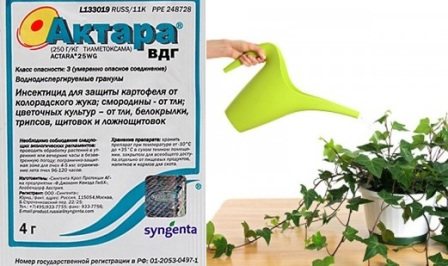

Aktara is available in the form of instant granules or suspensions. Granules are packaged in vacuum bags weighing 4 g. They are convenient for processing indoor plants, strawberries, as well as flower beds of violets, orchids and roses. Aktar is also sold in 250-gram bags. Such volumes are used to treat large horticultural plots, farms or plantations. There is also liquid Aktara. It is available in ampoules (1.2 ml) and vials (9 ml).
Properties and purpose
Insecticide Aktara has a number of distinctive features that distinguish it from the mass of other similar drugs:
- protection against many insect pests (about a hundred species);
- well absorbed by roots and leaves;
- speed (Aktara manifests itself already after 30-60 minutes after processing);
- active in all weather conditions;
- resistant to intense sunlight;
- long-term action of the agent (1-2 months);
- small consumption rate and infrequent treatments;
- toxins do not accumulate in the plant;
- high efficiency both when spraying stems and foliage, and when watering the soil.
Aktara helps to improve the quality of foliage and fruits, helps to get rid of pests and protects the plant from repeated insect attacks. The period of protective action of the drug is 1-2 months.
Areas of use
Aktara is widely used in horticulture and agriculture.This insecticide kills many of the most common insect pests. Among them:
- Colorado beetle;
- aphid;
- moth;
- shield;
- soil fly;
- thrips;
- whitefly;
- Chafer.
And this is a far from complete list. There is controversy over the spider mite. Houseplants are often attacked by him. The instructions for the drug say that Aktara is ineffective against all types of ticks. However, many gardeners and housewives claim that in case of a primary defeat by this pest, the remedy copes with it completely.
Precautions
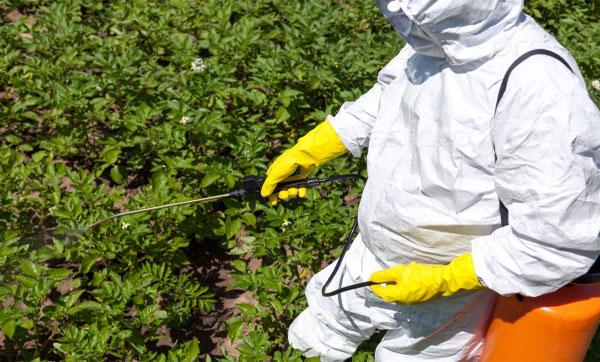

It is imperative to work with Aktara in a mask, gloves and glasses, it is recommended to wear clothes that cover the body. When spraying plants, do not drink, do not smoke, do not eat anything. Take flowers out of the room or process them with open windows. If the liquid gets on the skin, mouth, eyes, rinse them with clean water. If poisoning occurs, urgently consult a doctor, taking the package from the drug with you. This is unlikely, though. Hazard class - 3. It is not phytotoxic, but it does harm to bees, so flowering trees are not sprayed with it.
Advantages and disadvantages
Each insecticide has its own strengths and weaknesses. Aktara is no exception. Let's analyze the main "pros" and "cons" of the drug.
Benefits:
- High efficiency.
- High-speed performance.
- After processing the plant, the fruits remain harmless to human health.
- Wide range of applications.
- When used correctly, it is not addictive to insects.
- Efficiency does not depend on weather conditions.
- Long lasting action.
- Small consumption rate.
- Possibility of soil cultivation.
- Detailed instructions for use are present on the packaging of the drug.
Disadvantages:
- poisonous to wasps, bees and hornets;
- the inability to store the working solution;
- alternation with other insecticides is recommended.
Compatibility with other drugs
Aktara has good compatibility with other drugs, it is compatible with most insecticides and fungicides, as well as growth regulators. Except those that create an alkaline reaction. However, you should always test this by mixing a small amount of the two drugs to test their interaction. If there is no violent reaction, change in color or temperature, release of bubbles or precipitation, then the funds can be combined. Otherwise, you will have to use them separately.
The effectiveness of Aktara liquid
Currently, many gardeners have begun to use the drug "Aktara". They gave their preference to this remedy for its broad spectrum of action. When sprayed, the preparation exhibits a translaminar effect and hydrolytic stability.
The use of Aktara's insecticide will help to simultaneously solve all the pest problems that have arisen. This pesticide is compatible with many other insecticides and pesticides. But in each individual case, a drug compatibility test must be carried out.
This popular remedy allows you to preserve the leaf apparatus and significantly improve the quality of the crop. It is quite economical, and the consumption of the substance is minimal. On average, you need to carry out two spraying procedures per month to obtain maximum effect.
It should be noted that climatic conditions have practically no effect on the use of this drug.
Safety regulations
Aktara has a 3rd level of toxicity. Therefore, it is very important to follow the safety rules while working with this tool. These rules are described in detail by the manufacturer on the packaging.
So, the safety rules:
- Preparatory work should only be carried out outdoors.
- The person must be dressed in overalls, hands must be protected with special gloves.
- A prerequisite is the use of a respirator and goggles.
- It is strictly forbidden to eat and smoke when working with Aktara.
- After the work with the solution is completed, the respirator and gloves should be thrown away, changed, wash your hands with soap and water and rinse your mouth well.
- Contamination of reservoirs and wells with an insecticide is unacceptable.
What pests does Aktara fight with?
This insecticide successfully and effectively fights the following "harmful" bugs:
- Colorado and May beetles;
- spider mite;
- whitefly;
- shield;
- beetle larvae;
- aphids;
- thrips and a number of insects.
Drops of solution with Aktara fall on bugs, caterpillars and their larvae, through their skin - inside, where they begin to act. Eating foliage and nutrients from plant cells into which this drug has penetrated, this poisonous substance also enters the insect organism. The insecticide is detrimental to their nervous system, therefore, after ½ hour, these pests are no longer able to move or eat, and after some time they simply die. When it enters the soil, this poisonous substance begins to affect harmful insects that live in the soil.
This granular insecticide in a small package costs 76 - 100 rubles, and a pack of ¼ kg - from 3500 to 5000 rubles. The place where this poisonous drug will be located should be inaccessible to kids or pets. These can be mezzanines, shelves at the top of the room, closets, well closed.
Do not store this product near food, medicine, or pet food. The air temperature in this room can be from -10⸰C to + 35⸰C with low humidity.
Cost and types of product
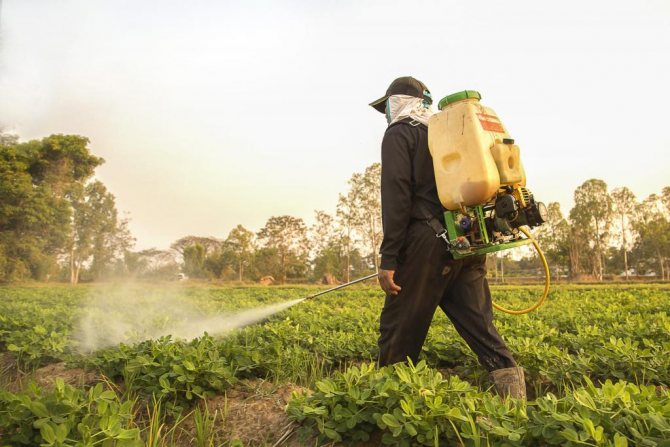

The drug costs up to 100 rubles for 4 grams. About 4000 rubles costs 250 g. You need to store the packaging in a dry place, in closed cabinets so that animals and children do not get there.
It is not recommended to store the substance in the refrigerator or near food. The temperature is 10-30 degrees Celsius.
There is a different release of the drug. The drug itself is shipped from Switzerland. It protects vegetables, orchids, violets, roses, houseplants. "Aktara" from the tick helps fight the pest, but the drug does not guarantee its complete disappearance. Views:
- Solids (4 g sachet). This is enough to spray tomatoes in a greenhouse. Of course, wholesale discounts are available for large farms.
- Suspension for processing.
Testimonials
Those people who have already tried this miracle remedy for protecting their plants write about the following in their reviews:
- You need to spray indoor flowers from all sides, and even the pallet where they stand.
- It must be remembered that this product is toxic, but the smell is not harsh. All this makes its use possible even at home.
- The drug should be used no more than once every six months. And if there is a mealybug, then you need to process the plant 4 times within 4 days. Especially carefully you need to process the center of the flower, where most of the larvae are concentrated.
All users are satisfied and note the high efficiency of "Aktara" liquid.
So, user reviews about the insecticide:
- Galina Ivanovna Zolotareva from Nizhny Novgorod: “I have been breeding orchids for about 10 years now. But recently my flowers began to die. I could not understand for a very long time what was the matter, because I did everything right, looked after them carefully. But nothing helped. As a result, it turned out that the mealybug harms my favorites. One good friend advised to immediately use Aktara, until all the plants withered. And, lo and behold! After three sprays with an interval of 4 days, the chervinets left my flowers alone. And orchids continue to delight me with their beauty. Thank you Aktara! "
- Stepan Ignatievich Mikhalev from Krasnoyarsk: “I am an avid gardener and spend all my free time in the beds.And good for health and soul! But then I noticed that the potatoes I had planted were in a deplorable state - a Colorado potato beetle appeared in the garden. What have I not tried ... The only salvation was the Aktara insecticide. After just one treatment, the number of pests has significantly decreased. I think this drug is very effective against these pests. "
- Olga Sergeevna Kazantseva from Ufa: “All my life I have been breeding houseplants. Recently, I have been spending more time on roses. Once I noticed that my darlings began to wither before our eyes. Apparently, some kind of pest has started up. Experienced flower growers advised to use the drug "Aktara". Especially carefully you need to process the center of the flower, where most of the larvae are concentrated. I was very pleased with the effect of this drug. And now I advise everyone to "Aktar".
How to process
If Aktar is diluted and applied together with fertilizer, which is allowed by the manufacturer, then the rate and dosage should not be changed. Be sure to check for fungicide compatibility.
An effective means of control will work in two ways of application: watering, spraying. The second method is applicable in soil and greenhouses. It is required to completely wet the soil and the entire green part of the plant.
But choosing an option is not enough. It must be remembered that the processing is carried out taking into account the type of plant, its relation to berry, vegetable or fruit crops.
Storage conditions
The drug is valid for the entire specified period on the package (4 years from the date of release). But this is subject to proper storage, open or closed. The temperature regime is permissible from -10 to +30 degrees.
The substance is kept away from foodstuffs. Keep animals away from packaging or prepared working solution. Do not store near flammable substances.
After using a working agent for processing purposes, it is not recommended to use a container or container for other substances. It is advisable to burn it away from the residential area. Do not inhale smoke, vapors or combustion products.
It is worth remembering that the prepared solution will need to be used completely. Cannot be stored and used within 6 hours after preparation.
Instructions for use
It is necessary to start processing plants when the first signs of the presence of pests (or their larvae and caterpillars) are detected. The details of the preparation of the solution and its subsequent use will be considered further.
Preparation of the solution
For convenience, the mother liquor is first prepared, and only then the working solution. What is the essence of the mother liquor? A container with a volume of at least 1.5-2 liters is taken. In it, the contents of the package (4 g) are dissolved in 1 liter of water. Next, a working solution is prepared (directly in the sprayer).
Mechanism of action
"Aktara" has a wide range of effects on the insect organism, which manifests itself in three directions:
- Contact. The death of an insect, larva or eggs occurs upon contact with the drug.
- Intestinal. Together with food, thiamethoxam enters the intestines of a beetle or larva and causes poisoning and death of the insect.
- Systemic. After spraying, thiamethoxam accumulates in the plant, which in itself becomes poisonous to the harmful insect.
The active substance is absorbed into the vascular system of the plant and retains its effect for 20-60 days. This allows you to influence even those insects that live on the plant in the most inaccessible places.
Can I use indoor flower cleaner?
The use of Aktara for indoor flowers is not prohibited. But you need to avoid getting the components directly on the flowers themselves.
The drug is used when:
- moths;
- aphids;
- soil fly;
- scabbards;
- thrips;
- whitefly and other insects that feed on plant tissues.
Caution! Improper use of the product harms the health of the crop, which leads to its death.
Therefore, before processing, you need to study the annotation.
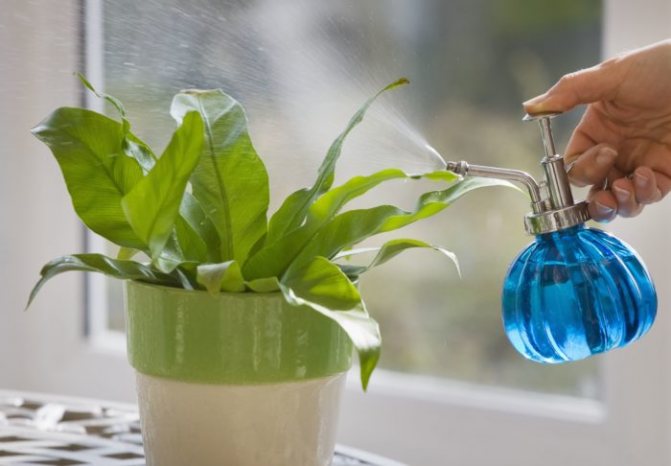

Protection from the most intrusive
Some pests are much more difficult to deal with than others. Some of the most annoying are aphids, whiteflies, mealybugs. For cucumbers, Aktara is considered the best salvation from aphids. The chemical enters the body of this pest through food contact. A minimum concentration of the chemical will be sufficient to poison the insect. The death of weak organisms occurs already during direct processing.
Attention! The properties of protection against aphids will be maintained for 15-30 days. The period depends on the weather conditions.
On cucumbers, aphids multiply too actively. Therefore, not only powder, suspension, but also special tablets and granules are used. The exact process for preparing a solution for spraying cucumbers and other crops was given above. As a general principle, we can say that aphids are a weak pest, so 2 grams of powder is enough for 10 liters of liquid. It is necessary to use a ready-made mixture within 2 days from the moment of dilution. Then it will become unusable.
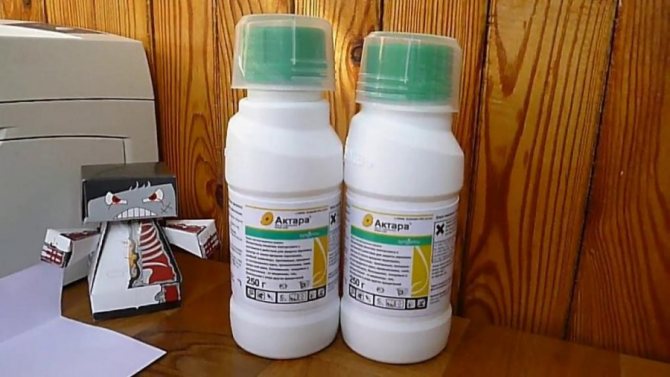

The cost of the original drug 250 g - 3500-5000 rubles
It is necessary to spray cucumbers before the first leaves appear, in early spring, the second time after flowering. At other times, the use of the chemical is not allowed, you will have to use other methods of fighting aphids. In the photo, you can see that the container with the drug is quite large. The tool actively fights whitefly. For the greatest effect, you do not need to spray the plants, but water them at the root.
This method of dealing with this pest is best suited. Whitefly larvae, adults - feed on the sap contained inside the stems of the plant. After the roots of Aktara are absorbed from the soil, it will mix with this natural component, penetrating into the pest's body. It is sometimes recommended to use a chemical more concentrated than indicated in the instructions on the package.
We are talking about a 3-4-fold increase in the dose of the active ingredient. How many liters are required in this case and with what concentration? The manufacturer's instruction says about a dilution of 1.4 g per 10 liters. Experienced gardeners argue about the need to dilute the same amount in 2-3 liters of liquid. Spraying a plant against a whitefly is considered ineffective. Watering is enough for the entire season.
The next particularly annoying pest is the mealybug. Most often it starts in indoor and ornamental plants on the street. There are many medicines to combat it, but Aktara is the most effective. Dilute 1 gram in 1.25 liters of liquid. This solution for orchids, roses, and other plants can be sprayed on 25-30 plants.
The watering method requires only 1 gram per 10 liters. The manufacturer allows the wrestling procedure to be repeated 4 times. 10-12 days should pass between each treatment, depending on weather conditions. The mealybug can be removed already by 2-3 treatments.
Specialist recommendation
Whatever form of release of "Aktara" is used granular or in suspension, when preparing the solution for work, it is better to dilute the drug with warm water, not lower than +250.
After application, when the systemic drug is absorbed into the tissues, it is not afraid of heat up to +400, but during processing and for 5-7 hours, the optimum temperature should be from +200 to +250, and the weather should be without wind and rain.
S. V. Meshcheryakov Candidate of Biol. n. leading agronomist of OOO SpetsSelkhozProekt.
Possible harm to plants and humans and how to minimize it
If you follow the instructions for using the drug and do not exceed the permissible concentration of Actara, then it will not cause any harm to indoor plants, even delicate and capricious orchids.With an excessively large application of Actara, plant sensitization (hypersensitivity) is possible. In this case, the application dose must be reduced.
Important!
Some pubescent flowers (for example, violets) can be damaged by spraying, so gentle watering should be used. With frequent watering, the permissible level of soil moisture can be violated. This should be taken into account so that due to excess moisture, sensitive plant roots do not begin to rot.
For humans and animals, Aktara is moderately toxic and belongs to the III (medium or moderate) hazard class. However, when handling it, you still need:
- use a respirator or gauze bandage, rubber or silicone gloves, goggles, a hat, overalls and appropriate footwear;
- while using a systemic insecticide, refrain from smoking, eating and drinking;
- thoroughly ventilate the room at all stages of work;
- work no more than 2 hours;
- refuse to use utensils that have come into contact with the substance for food purposes;
- store the drug at the permissible temperature range from +10 to +35 C, out of the reach of children and animals.
After all procedures, wash your face and hands with soap, rinse your mouth, change into clean clothes.
The following symptoms indicate insecticide poisoning:
- decreased motor functions;
- convulsions;
- nausea;
- vomiting;
- general weakness.
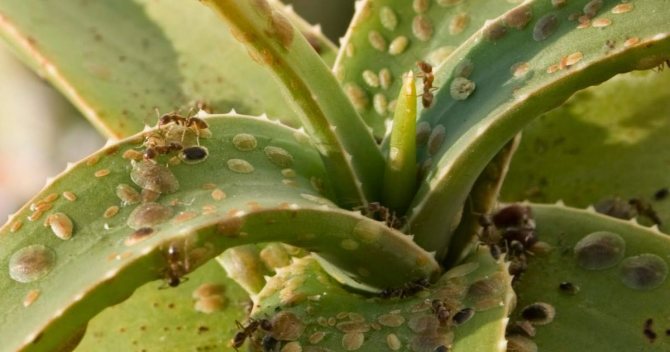

You may be interested in:
Scabbard on indoor plants - how to fight at home An inconspicuous insect in the form of a motionless plaque on a pet seems harmless at first, but in fact ... Read more ...
If such signs appear, then the victim should immediately suspend work. He must be taken to fresh air, given a glass of water with activated charcoal to drink, and then an additional 3 glasses of water and make him vomit (only if the person is conscious). After providing the necessary first aid, you should immediately contact a medical facility.
Chemical composition
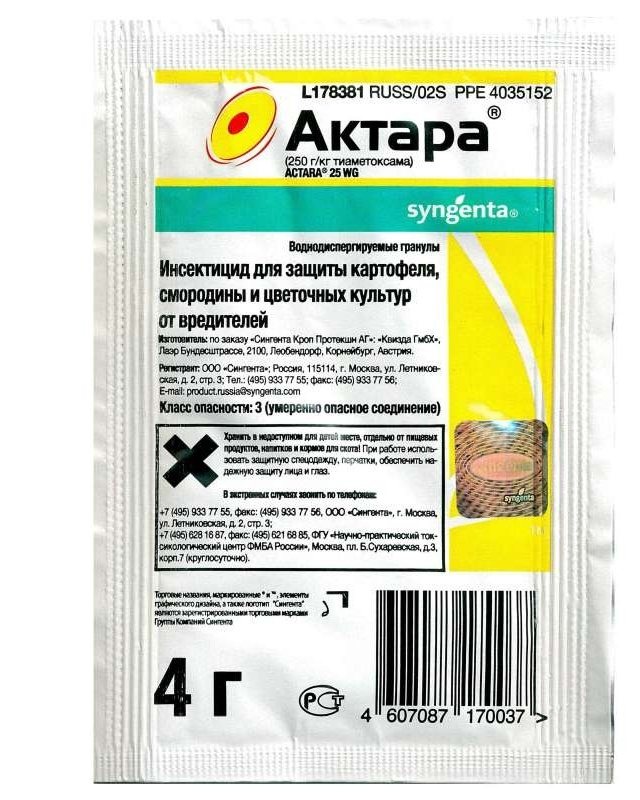

This systemic insecticide contains thiamethoxam. The descriptions of the chemical describe the main uses. It is applied by spraying, watering, tree processing. The substance is transported through the vessels of plant transport to the leaves and stem.
The drug is not afraid of bad weather conditions, it is quickly distributed over the vegetative organs of the plant. The substance does not have a characteristic pungent odor, it is low-toxic to animals and humans.
"Aktara" easily dissolves in warm water, resistant to sunlight. The residual effect lasts for 50 days. However, this period is indicated if you added it to the soil. When spraying - 20-30 days.
"Aktara" from a spider mite
Spider mites very often infect indoor plants, it is very difficult to fight it, and not all means are effective. As for "Aktara", the instructions for use for indoor plants of which indicate that this tool is not suitable for fighting ticks, you can use it. Some growers claim that the remedy helps and the tick dies. But positive reviews about the action of the drug most often relate to the primary use. In subsequent spraying "Aktara" may not be as effective.
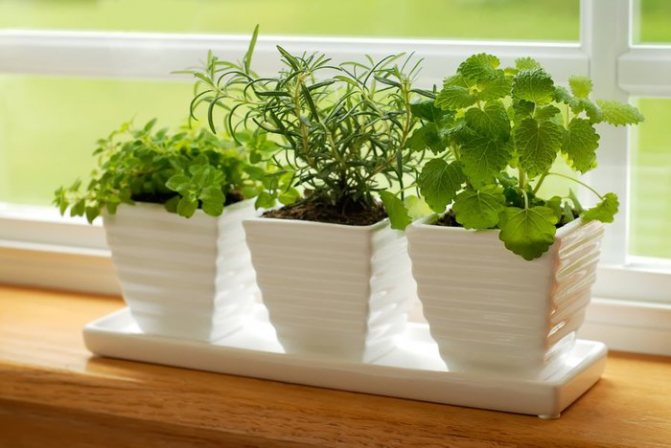

Category: "Questions and Answers"
Question number 1. How to apply the drug correctly for root watering of trees?
To make the treatment more effective, it is better to apply the solution away from the trunk. Ideally, if the product is poured evenly around the perimeter of the trunk circle, at the level where the crown ends. At this distance from the trunk, the bulk of the hairy roots is located, which absorb solutes from the soil.
Question number 2. A neighbor advised Aktar against spider mites. But after processing, there were even more of them.Why is this, after all, I did everything according to the instructions, maybe the product is of poor quality?
The product is all right. It's just not used for its intended purpose. "Aktara" is an insecticide against insects, and the spider mite is a pack-like one. Acaricides are needed against them.

